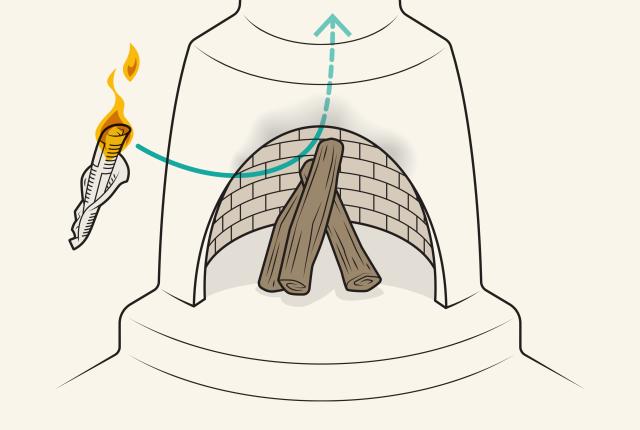Above: Use these tips for building a fire in a kiva-style fireplace. Illustration by Chris Philpot.
NEW MEXICANS LOVE THE AROMA of piñon smoke from a chimney. Well, at least northern New Mexicans do; farther south they cite mesquite or pecan smoke. None of them, though, will wax nostalgic about any kind of woodsmoke inside their home. But if you have a kiva fireplace—that classic beehive-shaped house warmer—it almost seems inevitable.
Or maybe not. Sam Gerberding, general manager of the Inn of the Governors, in Santa Fe, oversees 37 kiva-type fireplaces in the hotel’s guest rooms and its Del Charro restaurant. Lighting them is one of his favorite things to do. We asked for some tips.
Prime the chimney
“Take a rolled-up newspaper, light it like Indiana Jones’s torch in Raiders of the Lost Ark, and hold it up to the flue. On a cold or windy day, negative air pressure pushes down the chimney. This can warm it up so the fire’s smoke goes where you want it to.”
Think lean
“Kiva fireplaces are shallower than normal fireplaces, and that changes the airflow. Put, say, three logs with rough edges on their ends, angled up against the back of the firebox, so the wind flow carries the smoke up the chimney. And don’t overload it. You want a moderate-size fire.”
Shrug off the smoke stain
“At home, I have a kiva fireplace and I light it with all my supposed wisdom. We still get the smoke stain on the front. It’s inevitable. A satin or glossy paint makes it easier to clean off, but you sort of lose the aesthetic.”
HOW TO FAKE IT
Don’t have a fireplace? Don’t sweat. Dryland Wilds has you covered.
Using environmentally sensible gathering techniques, Cebastien Rose and Robin Moore, founders of the Albuquerque-based Dryland Wilds, craft piñon-scented products that are among their top sellers. Piñon resin from dead trees turns into an incense sold with natural bamboo charcoal to smolder it on. “It smells exactly like a piñon fire,” Rose says.
Other popular products include piñon woodsmoke soap, beard oil, and body oil crafted by infusing the resin for three weeks in a mix of jojoba and coconut oils. A piñon perfume uses resin as well as needles and wood for what Rose calls a “luscious aroma.”


